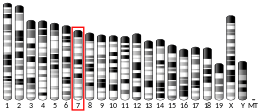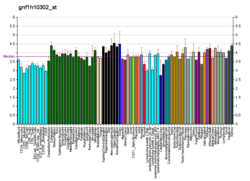OR51E1
Olfactory receptor 51E1 is a protein that in humans is encoded by the OR51E1 gene.[5]
Olfactory receptors interact with odorant molecules in the nose, to initiate a neuronal response that triggers the perception of a smell. The olfactory receptor proteins are members of a large family of G-protein-coupled receptors arising from single coding-exon genes. Olfactory receptors share a 7-transmembrane domain structure with many neurotransmitter and hormone receptors and are responsible for the recognition and G protein-mediated transduction of odorant signals. The olfactory receptor gene family is the largest in the genome. The nomenclature assigned to the olfactory receptor genes and proteins for this organism is independent of other organisms.[5]
Ligands
The receptor is associated with some compounds with a "cheese" or "sour" scent note. Examples of compounds that activate OR51E1 include:
- butyl butyryl lactate[6]
- isovaleric acid[7]
- nonanoic acid[6]
- 3-methylpentanoic acid[8]
- 4-methylpentanoic acid[8]
The following are in decreasing order of activity:[9]
- butyric acid
- methyl eugenol
- methyl salicylate
- (+)-menthol
- eugenyl acetate
- 2,4-dinitrotoluene
- pyrazine
- dimethyl disulfide
- methyl furfuryl disulfide
- pentanol
- propanal
See also
References
- GRCh38: Ensembl release 89: ENSG00000180785 - Ensembl, May 2017
- GRCm38: Ensembl release 89: ENSMUSG00000070423 - Ensembl, May 2017
- "Human PubMed Reference:". National Center for Biotechnology Information, U.S. National Library of Medicine.
- "Mouse PubMed Reference:". National Center for Biotechnology Information, U.S. National Library of Medicine.
- "Entrez Gene: OR51E1 olfactory receptor, family 51, subfamily E, member 1".
- Saito H, Chi Q, Zhuang H, Matsunami H, Mainland JD (March 2009). "Odor coding by a Mammalian receptor repertoire". Science Signaling. 2 (60): ra9. doi:10.1126/scisignal.2000016. PMC 2774247. PMID 19261596.
- Mainland JD, Keller A, Li YR, Zhou T, Trimmer C, Snyder LL, et al. (January 2014). "The missense of smell: functional variability in the human odorant receptor repertoire". Nature Neuroscience. 17 (1): 114–20. doi:10.1038/nn.3598. PMC 3990440. PMID 24316890.
- Yoshifumi Fujita 1, Tomoko Takahashi, Akiko Suzuki, Kayo Kawashima, Futoshi Nara, Ryuta Koishi (Oct 2008). "Deorphanization of Dresden G Protein-Coupled Receptor for an Odorant Receptor". Journal of Receptors and Signal Transduction. 27 (4): 323–334. doi:10.1080/10799890701534180. PMID 17885925.CS1 maint: uses authors parameter (link)
- Kaylin A. Adipietro, Joel D. Mainland, Hiroaki Matsunami (July 2012). "Functional Evolution of Mammalian Odorant Receptors". PLoS Genetics. doi:10.1371/journal.pgen.1002821. PMC 3395614. PMID 22807691.CS1 maint: uses authors parameter (link)
Further reading
- Wang J, Weng J, Cai Y, Penland R, Liu M, Ittmann M (June 2006). "The prostate-specific G-protein coupled receptors PSGR and PSGR2 are prostate cancer biomarkers that are complementary to alpha-methylacyl-CoA racemase". The Prostate. 66 (8): 847–57. doi:10.1002/pros.20389. PMID 16491480.
- Weng J, Wang J, Hu X, Wang F, Ittmann M, Liu M (March 2006). "PSGR2, a novel G-protein coupled receptor, is overexpressed in human prostate cancer". International Journal of Cancer. 118 (6): 1471–80. doi:10.1002/ijc.21527. PMID 16206286.
- Weigle B, Fuessel S, Ebner R, Temme A, Schmitz M, Schwind S, et al. (September 2004). "D-GPCR: a novel putative G protein-coupled receptor overexpressed in prostate cancer and prostate". Biochemical and Biophysical Research Communications. 322 (1): 239–49. doi:10.1016/j.bbrc.2004.07.106. PMID 15313197.
- Malnic B, Godfrey PA, Buck LB (February 2004). "The human olfactory receptor gene family". Proceedings of the National Academy of Sciences of the United States of America. 101 (8): 2584–9. doi:10.1073/pnas.0307882100. PMC 356993. PMID 14983052.
- Vanti WB, Nguyen T, Cheng R, Lynch KR, George SR, O'Dowd BF (May 2003). "Novel human G-protein-coupled receptors". Biochemical and Biophysical Research Communications. 305 (1): 67–71. doi:10.1016/S0006-291X(03)00709-5. PMID 12732197.
- Adams MD, Kerlavage AR, Fleischmann RD, Fuldner RA, Bult CJ, Lee NH, et al. (September 1995). "Initial assessment of human gene diversity and expression patterns based upon 83 million nucleotides of cDNA sequence" (PDF). Nature. 377 (6547 Suppl): 3–174. PMID 7566098.
External links
- OR51E1+protein,+human at the US National Library of Medicine Medical Subject Headings (MeSH)
This article incorporates text from the United States National Library of Medicine, which is in the public domain.




